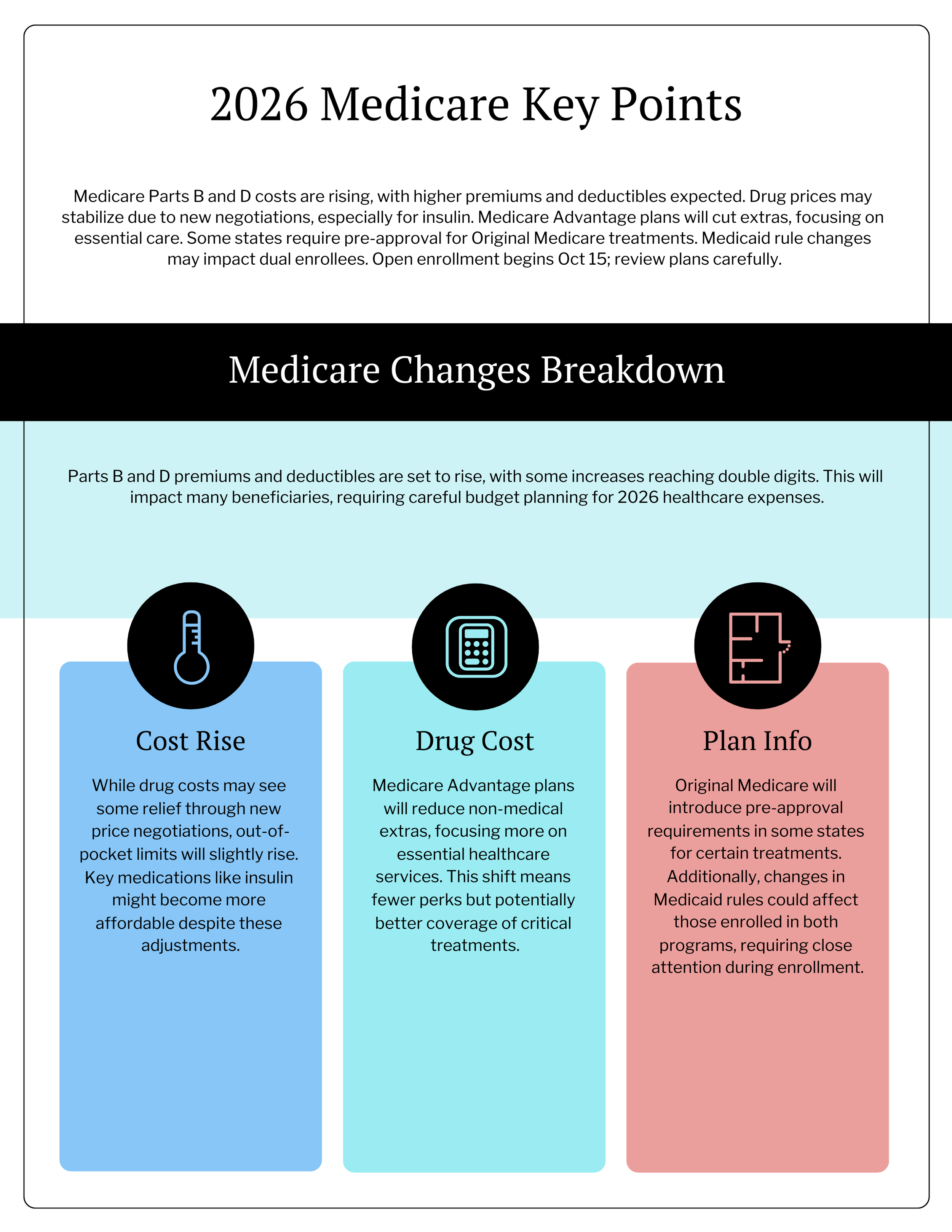10 Important Medicare Changes Happening in 2026
Medicare open enrollment starts October 15 and runs until December 7. This is your chance each year to review your coverage, compare plans, and make changes that fit your health and budget.
The year 2026 brings big shifts to Medicare. Some are routine, like higher premiums and deductibles, while others could change how you get care and what you pay for prescriptions.
Here are the major changes you need to know before open enrollment begins.
1. Premiums and Deductibles Are Rising
Medicare costs are going up across the board.
Part B premiums (doctor visits and medical services) are projected to increase 11.6 percent, from $185 to $206.50.
Part D premiums (prescription drug coverage) are estimated to rise 6 percent, from $36.78 to $38.99.
Deductibles are climbing too: Part B from $257 to $288 and Part D from $590 to $615.
These annual increases usually follow health-care inflation, but the jump will hit hardest for people on fixed incomes.
2. The Drug Cost Cap Moves Higher
The catastrophic threshold for Part D, the point after which you pay nothing for covered drugs, will rise from $2,000 to $2,100. Even with the increase, it still protects seniors from runaway prescription costs. If you have Part D coverage, your plan pays 100 percent of approved medication costs once you reach the limit.
3. Paying for Prescriptions Will Get Easier
The Medicare Prescription Payment Plan lets you spread your out-of-pocket drug costs evenly through the year instead of paying everything at once.
Starting in 2026, if you enroll in the plan, you’ll stay enrolled automatically for the next year unless you opt out. You’ll receive a renewal notice before the next enrollment period explaining any changes. If you cancel, the plan must process your request within three days.
Get your free tax‑saving plan for retirement
4. Fewer Extra Perks in Medicare Advantage Plans
Medicare Advantage plans—private plans that bundle hospital, medical, and drug coverage are cutting back some non-medical extras called Special Supplemental Benefits for the Chronically Ill (SSBCI).
Beginning in 2026, they can no longer cover:
Non-healthy food
Alcohol
Tobacco
Life insurance
This continues a trend of insurers reducing add-on perks like over-the-counter drug allowances or free transportation. These plans will now focus more on core health services, prescription coverage, and provider networks.
5. Some Original Medicare Users Will Need Pre-Approval
A new pilot program in six states—Arizona, New Jersey, Ohio, Oklahoma, Texas, and Washington—will require pre-authorization for more procedures under Original Medicare.
You’ll need approval before getting certain services such as skin and tissue substitutes, nerve stimulator implants, and arthroscopic knee surgery. Inpatient and emergency care remain exempt.
These rules mirror what many Medicare Advantage plans already use, where 99 percent of members face some form of prior authorization. Critics argue it delays care, and 75 percent of denials are later overturned on appeal.
Medicare 2026 Infographic
6. Drug Prices Are Finally Being Negotiated
For the first time, Medicare will negotiate directly with drug manufacturers. In 2026, price reductions will apply to ten high-cost drugs:
Eliquis, Enbrel, Entresto, Farxiga, Imbruvica, Januvia, Jardiance, Fiasp / NovoLog, Stelara, and Xarelto.
The initial list is short, so savings will be modest next year. But it’s a major step toward lowering medication costs long term. More drugs, including popular weight-loss medications like Ozempic, Rybelsus, and Wegovy, are already scheduled for 2027 negotiations.
7. Insulin Will Be Even Cheaper
The $35 monthly insulin cap that started in 2023 will become more flexible in 2026. You’ll pay the lower of:
$35,
25 percent of the government’s negotiated “fair price,” or
25 percent of your plan’s negotiated price.
That means many insulin users could see lower costs than the flat $35 limit.
Get your free tax‑saving plan for retirement
8. Free Vaccines Remain but Access Might Tighten
Medicare will continue to cover all adult vaccines recommended by the Advisory Committee on Immunization Practices at no cost—no deductible, copay, or coinsurance. This includes COVID-19, RSV, and Shingles vaccines.
However, the recent removal of all 17 ACIP members by the Health and Human Services Secretary raises concerns about how vaccine recommendations will be updated. Experts warn that political uncertainty and distribution challenges could make some vaccines harder to get, even if they remain free.
9. Dual Medicare-Medicaid Recipients Could Lose Coverage
The GOP’s “One Big Beautiful Bill Act” introduced new Medicaid work and enrollment requirements. While seniors and people with disabilities are exempt from the work rule, they still face tougher eligibility checks every six months.
Those who fail to complete the paperwork could lose Medicaid benefits that pay for services Medicare doesn’t—like long-term care, dental, vision, and hearing.
The law also delayed a rule designed to make it easier to enroll in Medicare Savings Programs, which help low-income individuals pay Medicare premiums. Losing access to either Medicaid or these subsidies could make coverage unaffordable for many.
10. Federal Spending Cuts Could Hit Medicare
The same bill is projected to add $3.4 trillion to the national deficit by 2034. That increase could trigger automatic Medicare funding cuts under the Pay-As-You-Go law.
Unless Congress acts, the Congressional Budget Office estimates Medicare could face $45 billion in cuts for 2026 and more than $500 billion by 2034. Even if lawmakers intervene, the strain on the overall health-care system could mean fewer services and more hospital closures in the long run.
How to Prepare for Open Enrollment
The upcoming changes mean you should review your plan carefully this fall. Here’s how to protect your coverage and budget:
Medicare Open Enrollment
Don’t automatically re-enroll. Plans can change each year—networks shrink, premiums rise, and benefits disappear. Confirm your doctors and prescriptions are still covered.
Check your drug list. Each Part D plan publishes a formulary showing which medications it covers. With drug price negotiations underway, formularies may change in 2026.
Compare plans. Look beyond premiums. Factor in deductibles, copays, and coverage for the care you use most.
Get professional help. A licensed, independent Medicare broker can explain your options and help you switch between Medicare Advantage, Original Medicare, or Medigap plans.
Plan ahead for costs. Budget for the higher premiums and deductibles now, especially if you live on fixed income.
How One Advisory Partners Helps You with Medicare
As a fiduciary wealth management firm, One Advisory Partners helps you simplify complex financial decisions and feel confident about your future. Our advisors guide you through retirement income planning, investment management, and tax strategy so you can prepare for rising healthcare costs, protect your wealth, and focus on living well in your next chapter..
The Bottom Line
The 2026 Medicare updates bring higher costs, new rules, and ongoing political uncertainty. Still, there are bright spots such as negotiated drug prices, flexible insulin caps, and continued free vaccines.
Your best move is to stay informed. Review your plan between October 15 and December 7, compare all available options, and reach out for expert guidance if you are unsure. A little preparation now could save you significant money and frustration next year.
FAQs: Medicare Changes in 2026
1. When is Medicare open enrollment?
Open enrollment runs from October 15 to December 7, 2025. This is your chance to review your current plan, compare options, and make changes for 2026 coverage.
2. How much will Medicare premiums increase in 2026?
Part B premiums are expected to rise from $185 to $206.50.
Part D base premiums will increase from $36.78 to $38.99.
3. What happens to Medicare deductibles next year?
The Part B deductible will increase to $288, and the Part D deductible will rise to $615.
4. What is the new Part D catastrophic threshold?
The out-of-pocket cap for prescription drugs under Part D will rise from $2,000 to $2,100 in 2026.
5. Will insulin still be capped at $35 per month?
Yes. Starting in 2026, you’ll pay the lower of:
$35,
25 percent of the Medicare fair price, or
25 percent of your plan’s negotiated price.
This means many insulin users could see lower costs than before.
6. Which drugs will have new negotiated prices?
In 2026, Medicare will roll out negotiated prices for ten high-cost drugs:
Eliquis, Enbrel, Entresto, Farxiga, Imbruvica, Januvia, Jardiance, Fiasp/NovoLog, Stelara, and Xarelto.
7. Are Medicare Advantage plans changing?
Yes. Starting in 2026, Medicare Advantage plans can no longer include non-medical perks such as:
Alcohol
Tobacco
Life insurance
Non-healthy food options
8. Will Original Medicare require prior authorization?
In Arizona, New Jersey, Ohio, Oklahoma, Texas, and Washington, some outpatient procedures will require pre-approval before treatment begins.
9. Do vaccines remain free under Medicare?
Yes. All adult vaccines approved by the Advisory Committee on Immunization Practices will continue to have no copay, deductible, or coinsurance in 2026.
10. How can I prepare for these Medicare changes?
Review your plan before open enrollment ends.
Compare coverage, drug lists, and costs.
Talk to an independent Medicare broker if you need help choosing.
Reference
Centers for Medicare & Medicaid Services. (2025). Contract Year 2026 Policy and Technical Changes to the Medicare Advantage Program and Medicare Prescription Drug Benefit Program. Retrieved from https://www.cms.gov/newsroom/fact-sheets/contract-year-2026-policy-and-technical-changes-medicare-advantage-program-medicare-prescription-final
Centers for Medicare & Medicaid Services. (2024). 2025 Medicare Parts B Premiums and Deductibles. Retrieved from https://www.cms.gov/newsroom/fact-sheets/2025-medicare-parts-b-premiums-and-deductibles
Centers for Medicare & Medicaid Services, Office of the Actuary. (2025). 2025 Trustees Report. Retrieved from https://www.cms.gov/oact/tr/2025
Investopedia. (2025). 10 Major Medicare Changes Coming in 2026: What to Expect with Premiums, Drug Prices and Program Cuts. Retrieved from https://www.investopedia.com/10-major-medicare-changes-coming-in-2026-what-to-expect-with-premiums-drug-prices-and-program-cuts-11819826



